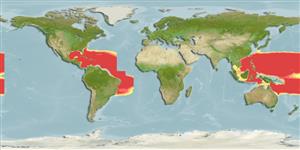>
Trachichthyiformes (Roughies) >
Anoplogastridae (Fangtooths)
Etymology: Anoplogaster: Greek, ana = up + Greek, oplon = shield + Greek, gaster = stomach (Ref. 45335); brachycera: From the main characters of the young specimens which have short temporal and pre-opercular spines..
Environment: milieu / climate zone / depth range / distribution range
Ecología
marino batipelágico; rango de profundidad 0 - 1500 m (Ref. 31253). Deep-water
Pacific and Atlantic: tropical waters, from the Sulu Sea in the western Pacific and from the Gulf of Mexico to north of the Bahamas Islands in the western Atlantic (Ref. 50735); off southeastern USA (Moore, pers. comm.).
Tamaño / Peso / Age
Maturity: Lm ? range ? - ? cm
Max length : 6.0 cm SL macho / no sexado; (Ref. 31253)
Minimum depth from Ref. 58018.
Life cycle and mating behavior
Madurez | Reproducción | Puesta | Huevos | Fecundidad | Larva
Paxton, J.R., 1999. Order Beryciformes. Anoplogastridae. Fangtooths. p. 2210. In K.E. Carpenter and V.H. Niem (eds.) FAO species identification guide for fishery purposes. The living marine resources of the WCP. Vol. 4. Bony fishes part 2 (Mugilidae to Carangidae). FAO, Rome. (Ref. 9852)
IUCN Red List Status (Ref. 130435)
Threat to humans
Harmless
Human uses
Pesquerías: sin interés
Más información
Nombres comunesSinónimosMetabolismoDespredadoresEcotoxicologíaReproducciónMadurezPuestaAgregación para la puestaFecundidadHuevosEgg development
Age/Size
Crecimiento
Length-weight
Length-length
Length-frequencies
Morfometría
Morfología
Larva
Dinámica larvaria
Reclutamiento
Abundancia
BRUVS
ReferenciasAcuiculturaPerfil de acuiculturaRazasGenéticaElectrophoresesheritabilidadEnfermedadesProcesamientoNutrientsMass conversion
ColaboradoresImágenesStamps, Coins Misc.SonidosCiguateraVelocidadTipo de nataciónSuperficie branquialOtolitosCerebrosVisión
Herramientas
Special reports
Download XML
Fuentes de Internet
Estimates based on models
Preferred temperature (Ref.
123201): 7.2 - 18.9, mean 11.1 °C (based on 563 cells).
Phylogenetic diversity index (Ref.
82804): PD
50 = 1.0000 [Uniqueness, from 0.5 = low to 2.0 = high].
Bayesian length-weight: a=0.01995 (0.00906 - 0.04395), b=3.01 (2.83 - 3.19), in cm total length, based on all LWR estimates for this body shape (Ref.
93245).
Nivel trófico (Ref.
69278): 3.3 ±0.5 se; based on size and trophs of closest relatives
Fishing Vulnerability (Ref.
59153): Low vulnerability (10 of 100).
